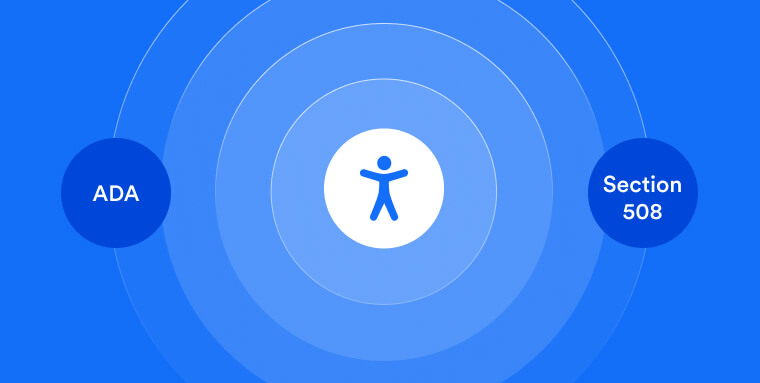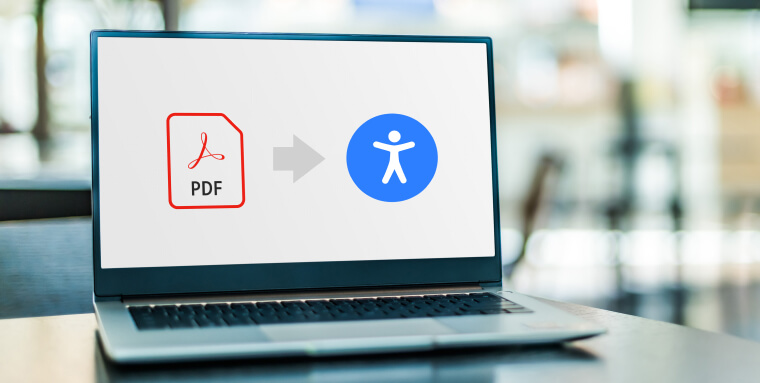The information presented within this guide is aimed at website owners seeking to learn the ropes of web accessibility. Technical elements are described in layman’s terms, and, as a rule, all topics pertaining to the legalities of web accessibility are presented in as simplified a manner as possible. This guide has no legal bearing, and cannot be relied on in the case of litigation.
When you comply with the Americans with Disabilities Act (ADA) and Section 508 of the Rehabilitation Act, you give all website visitors the opportunity to access your website and online documents.
Because they both apply to web accessibility, the ADA and Section 508 are often confused with each other.
In this blog, we will cover the differences between them, and we’ll also explain the best ways for your business or federally-funded organization to comply with these laws.
Comparing the ADA and Section 508

While the ADA and Section 508 exist to ensure equal rights for people with disabilities, they are not the same legislation.
Section 508 of the Rehabilitation Act of 1973 only applies to government agencies, organizations that receive federal funding, and service providers to federally-funded organizations. Conversely, the ADA applies to private businesses (with the exception of religious organizations and private clubs).
The ADA and Section 508 also have slightly different standards for web accessibility, which we will cover in more detail later in the blog.
What is the ADA and what is ADA compliance?
The ADA stands for the Americans with Disabilities Act. Signed into law in 1990, the ADA prohibits discrimination against the disability community, and is a very broad piece of legislation that covers many different topics related to accessibility.
If you’re a business owner, you should be familiar with ADA Title III.
ADA Title III requires businesses classified as “public accommodations” to make reasonable modifications to ensure their facilities and services are accessible to people with disabilities. Public accommodations are businesses that are open to and serve the public, such as restaurants, colleges, hotels, banks, movie theaters, public transportation, and many small businesses.
As the internet’s impact on everyday life continues to grow, various courts across the U.S. have ruled that these businesses’ websites are now also included under ADA Title III. These rulings fit a 2018 affirmation issued by the Department of Justice (DOJ), stating that ADA accessibility requirements now extend to online spaces.
It’s important to note that nearly all places of business provide services and accommodations to the public. Thus, ensuring their websites and web-based applications (such as online documents and emails) are accessible and in compliance with the ADA is relevant to almost all businesses.
What is Section 508 and who does it apply to?
Section 508 of the Rehabilitation Act mandates that all federal agencies, organizations that receive federal funding, and service providers to federally-funded organizations, must make their information and communication technology (ICT) accessible to people with disabilities.
Applicable technologies include, but aren’t limited to:
- Websites
- Videos and other multimedia
- Electronic documents (e.g., PDF files)
- Emails
- Web and desktop applications
Organizations that do not receive federal funding or provide services to federally-funded organizations do not need to comply with Section 508.
How do you become ADA and Section 508-compliant?

Though both pieces of legislation apply to web accessibility, being Section 508-compliant does not automatically mean your website is ADA-compliant (and vice versa). Here’s what you need to know about meeting compliance requirements for both the ADA and Section 508:
How do you become ADA-compliant?
ADA Title III does not have a clear set of legal standards by which a website is considered accessible. However, it is generally agreed that to achieve ADA website compliance, websites should adhere to the Web Content Accessibility Guidelines (WCAG). Created by the World Wide Web Consortium (W3C), WCAG is an internationally accepted standard for web accessibility, and has been referenced by the DOJ as the standards websites should meet under the ADA.
Throughout the years, there have been a number of WCAG versions. WCAG 2.0 is an older version of the guidelines, and WCAG 2.1 is the most current version. WCAG 2.2, was initially released in February of 2020 and was officially published on October 5th, 2023.
There are three levels of conformance to WCAG 2.0 and 2.1:
- Level A - the minimum level of conformance
- Level AA - the most commonly-sought after level of WCAG conformance
- Level AAA - the most difficult level of conformance to achieve
To meet ADA web accessibility requirements, it is recommended to conform to WCAG 2.0 Level AA, at minimum.
While nothing is codified into law, it is worth noting that websites that conform to WCAG 2.1 Level AA are unlikely to face legal recourse under the ADA.
WCAG 2.1: a short breakdown
WCAG 2.1 includes a detailed list of recommendations to make your website more accessible to all visitors. To conform with WCAG 2.1, businesses will need to address the following action items:
- Ensure websites and online documents are compatible with screen reader technology:
People with vision impairments rely on screen reader tools to access digital content. For websites to be compatible with such devices, adjustments must be made at the code level - Provide alt text for meaningful images:
Alt text describes an image displayed on a web page. Read aloud by screen readers, alt text helps people with vision impairments understand the content and context of the image. It is important to note that for it to achieve the desired effect, alt text must properly and fully describe the image in question for those relying on screen readers to understand it. Additionally, alt text should only be added to images that, if removed, would result in a website visitor losing out on vital content. These images are called “meaningful images.” Non-meaningful images (i.e., the kind displayed only for decorative purposes) should be hidden from assistive technologies - Ensure sufficient color contrast between text and background:
The color contrast between text and its background should be high enough for people with color blindness or low vision to be able to read the text - Support any screen orientation:
Website visitors who mount their device to a mobility support may prefer one orientation over another. Ensure that website visitors can use your website in both portrait and landscape mode - Notify visitors of timeouts:
If a certain web page expires after a defined period of inactivity, certain website visitors can find this challenging. Therefore, they must be alerted if their web page will expire soon. This notification must include the option to turn off, adjust, or extend the time limit - Provide alternative formats for audio and/or video content:
Videos with audio content should include captions to accommodate people with hearing impairments, as well as audio descriptions for people with vision impairments - Ensure content is scalable:
Text must be able to be resized up to 200% without content becoming scattered or design elements losing their functionality
It is important to note that these are only some of the detailed recommendations outlined within WCAG 2.1. We recommend you check out this comprehensive ADA website compliance checklist to conform to WCAG 2.1 at Level A, AA, or AAA. If you're looking for inspiration when redesigning your website so that it conforms to WCAG 2.1 Level AA, you can take a look at these examples of stunning ADA-compliant websites.
How do you become Section 508-compliant?
Unlike the ADA, Section 508 has a clear standard for compliance. Organizations that must comply with Section 508 need to ensure their websites and other information and communication technology (ICT) conform to WCAG 2.0 Level AA.
Click here for a comprehensive Section 508 compliance checklist.
It’s important to note that under Section 508, organizations are required to document their ICT's level of conformance by completing a Voluntary Product Accessibility Template (VPAT).
To read more about VPATs and how you should approach them, you can read this blog.
How to test a website for ADA and Section 508 compliance
You can test your website for ADA compliance or for Section 508 compliance using automated testing tools, such as accessScan, and by relying on expert service providers, like accessServices.
To use accessScan, you will need to submit your website’s URL, after which the tool will run a quick, automated audit of your web page and check whether it conforms to WCAG 2.1 Level AA. After the audit is complete, you will be presented with detailed results that will help you address website elements that are non-accessible (if any exist).



